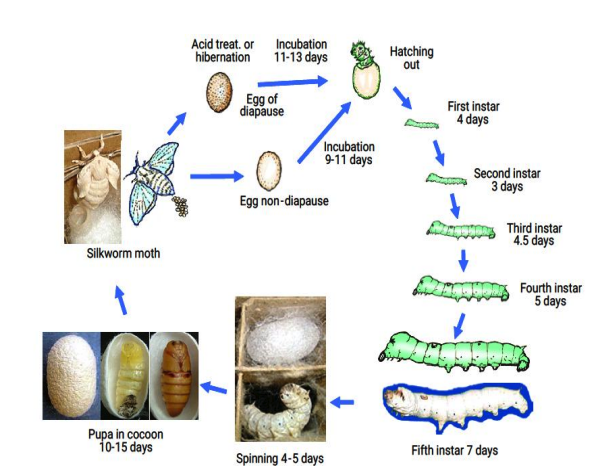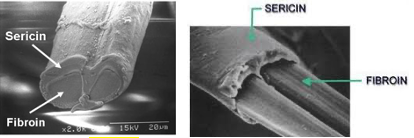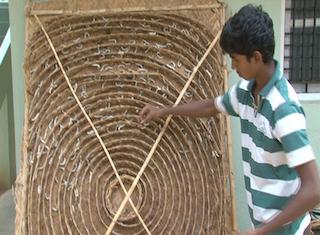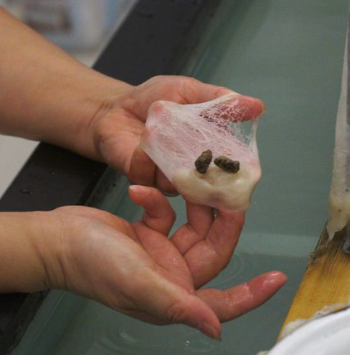🤹♀️ Life Cycle
Learn about stages of life cycle, moulting, DEL, Grainage, Harvesting of Silk
Which of the following statement is correct?
- Chemically speaking, silk is made of proteins secreted in the fluid state by a caterpillar, popularly known as ‘silkworm’.
- These silkworms feed on the selected food plants and spin cocoons as a ‘protective shell’ to perpetuate the life.
- Silkworm has four stages in its life cycle viz.,
- Egg
- Caterpillar
- Pupa
- Moth
- Man interferes this life cycle at the cocoon stage to obtain the silk, a continuous filament of commercial importance, used in weaving of the dream fabric.

- The production of silk generally involves two processes:
- Care of the silkworm from the egg stage through completion of the cocoon.
- Production of mulberry trees that provide leaves upon which the worms feed.
Moulting in silk worm
- Moulting is the process when silkworms seized feeding, becomes immobile and prepare themselves for shedding their old skin to accommodate the fast growth. During this process it sheds its skin and does not eat. This is because there is enormous enlargement in its size.
- Silkworm ceases feeding and form cocoon from outside to inside.
- A silkworm goes into molt phase five times in its life cycle of 30-35 days. (Complete life cycle: 40-55 days)
- Silkworm has 5 instars (tetramoulters means it undergoes moulting four times).
- The silkworm caterpillar builds its cocoon by producing and surrounding itself with a long, continuous fiber, or filament.
- Liquid secretions from two large
labial glandswithin the insect emerges from the spinneret, a single exit tube in the head, hardening upon exposure to air and forming twin filaments composed offibroin, aprotein material.
- A second pair of glands secretes
sericin, agummy substancethat cements the two filaments together. - An emerging moth would break the cocoon filament, therefore the larva is killed in the cocoon by steam or hot air at the
chrysalis stage. - Pupa of silkworm and butterfly is known as chrysalis.
- The removal of sericin from silk is termed as
Degumming. - Silk contains 75% fibroin (glycrine, analine, thyrosine) and 25% sericin.
Fibroinconstitutes the core of the silk filament forming two thin fibres calledbrinsandsericinconstitutes the rest of the gelatinous material.- The optimum temperature for spinning of silk by silkworm is
24°C,60-70%RH.
DEL - Disease free laying
- After emergence from the cocoon male moths immediately couple with female moths.
- After a period of 24-36 hours female moth lays eggs in about three batches.
- These eggs are cleaned washed and examined under the microscope for diseases specially pebrine.
- After a batch is certified as disease free then only it is used for rearing in the field.
- A DFL is a defined as Disease Free Laying that is a group of eggs laid out by a moth which has been certified as disease free.
- 1 disease free laying (1 DFL) = 400 eggs.
- 20,000 eggs/box is considered as universal standard unit for marketing of silkworm eggs.
Diapause
- After the cocoon has been spun and the pupa sets inside the cocoon it goes into hibernation or diapauses.
- In case of Tasar during the first crop at the onset of monsoon the pupa goes into diapause for one week.
- Since there is still sufficient humidity it emerges as a moth and the lifecycle is repeated.
- After the second crop winter sets in and there is not sufficient humidity.
- Therefore the pupa remains in the cocoon in the diapauses state for about six months till the next onset of monsoon.
- Bombyx mori when exposed to long days undergo diapause.
- For artificial breaking of diapause, hot HCl treatment is the common treatment given.
- Chilling of eggs in Bombyx mori results in egg hatching and diapause breaking.
- ‘Black boxing’ is done for uniform hatching of eggs.
- Brushing is the process of separating newly hatched larva gently and transferring them to rearing sheets.
Grainage
- Grainage is a place where silkworm seeds (eggs) are produced.
Mounting

- The transfer of ripened larvae to cocoonages.
- The process of transferring ripe worms the appliances used for support spinning by larva is called ‘Mounting’.
- Mountage: A device used for support of making cocoons by the silkworm larvae.
- Chandrika is a popular mountage in South India.
- The process of spinning takes place in 1-2 days (48 hours) in multivoltine races.
Harvesting

- Harvesting is done after pupal case has hardened preferably 5th day of spinning.
- The process of killing the cocoon is
Stifling. - The operation of unwinding and collecting the silk filament from cocoons is called
Reeling. - The percentage ratio of unbroken filament to the whole filament length represents
Reelabilityof cocoons. - ‘Filature’ is a large factory where reeling of cocoons is carried out with the help of advanced technology.
- Silk filament reeled out of double cocoons is called
Dupion silk.

- Sorting of cocoons is called
Riddling. - One silkworm larva can produce 650-1300 m of silk thread.
Denieris the unit to measure thethicknessorfineness of silkyarn.- 1 kg of raw silk is obtained from 7-8 kg of cocoons.
- Internationally accepted thickness of quality raw silk is
14 deniers. - An Indian silk bale weighs 50 kg against international one weighing 60 kg.
References
- https://csb.gov.in/
- https://agritech.tnau.ac.in/
- Wikipedia
- https://sericulture.assam.gov.in/
- https://agritech.tnau.ac.in
Which of the following statement is correct?
- Chemically speaking, silk is made of proteins secreted in the fluid state by a caterpillar, popularly known as ‘silkworm’.
- These silkworms feed on the selected food plants and spin cocoons as a ‘protective shell’ to perpetuate the life.
- Silkworm has four stages in its life cycle viz.,
- Egg
- Caterpillar
- Pupa
- Moth
- Man interferes this life cycle at the cocoon stage to obtain the silk, a continuous filament of commercial importance, used in weaving of the dream fabric.

- The production of silk generally involves two processes:
- Care of the silkworm from the egg stage through completion of the cocoon.
- Production of mulberry trees that provide leaves upon which the worms feed.
Moulting in silk worm
- Moulting is the …
Become Successful With AgriDots
Learn the essential skills for getting a seat in the Exam with
🦄 You are a pro member!
Only use this page if purchasing a gift or enterprise account
Plan
Rs
- Unlimited access to PRO courses
- Quizzes with hand-picked meme prizes
- Invite to private Discord chat
- Free Sticker emailed
Lifetime
Rs
1,499
once
- All PRO-tier benefits
- Single payment, lifetime access
- 4,200 bonus xp points
- Next Level
T-shirt shipped worldwide

Yo! You just found a 20% discount using 👉 EASTEREGG

High-quality fitted cotton shirt produced by Next Level Apparel